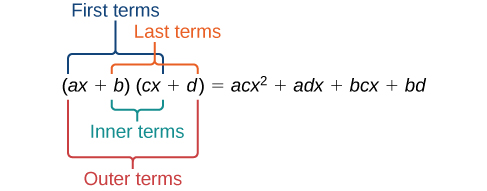- Multiply polynomials
Multiplying Polynomials
While adding and subtracting polynomials is straightforward, multiplication is a bit more intricate. It hinges on the distributive property, which necessitates multiplying every term of the first polynomial by each term of the second. For the special case of binomials, we have a helpful shortcut—the FOIL method, which stands for First, Outer, Inner, Last. This and other special multiplication patterns, like squaring a binomial, are tools that can make the process more efficient and are valuable to recognize.
Multiplying Polynomials Using the Distributive Property
The distributive property is the key to multiplying polynomials. It requires us to distribute, or multiply, each term of one polynomial by every term of the other polynomial.
How To: Use the Distributive Property to Multiply Polynomials
- Distribute: Multiply every term in the first polynomial by every term in the second polynomial.
- Combine: Look for like terms — terms with the same variables raised to the same power — and sum them.
- Simplify: Arrange the resulting polynomial in standard form, terms written in descending order of their degree.
Find the product.
[latex]\left(2x+1\right)\left(3{x}^{2}-x+4\right)[/latex]
When multiplying a binomial and another polynomial with two or more terms, be sure to multiply each term in the first to each term in the second.
Watch this video to see more examples of how to use the distributive property to multiply polynomials.
Using FOIL to Multiply Binomials

FOIL is a mnemonic that stands for First, Outer, Inner, Last, and it’s a technique used to multiply two binomials efficiently. Each word in the acronym FOIL represents a pair of terms to be multiplied together:
- First terms from each binomial
- Outer terms from each binomial
- Inner terms from each binomial
- Last terms from each binomial
The products from these multiplications are then added together to get the final expanded form of the polynomial.
How To: Multiplying Binomials Using FOIL
- Multiply the First terms of each binomial.
- Multiply the Outer terms.
- Multiply the Inner terms.
- Multiply the Last terms.
- Sum all the products.
- Combine any like terms to simplify the expression.
Use the FOIL method to find the product of the following:
Perfect Square Trinomials
When squaring a binomial, the result is known as a perfect square trinomial, which has a recognizable form. Instead of multiplying the binomial by itself, we can use a formula that simplifies the process.
Here are some examples of perfect square trinomials and the general pattern they follow:
The pattern here is clear: the first and last terms of the trinomial are the squares of the first and last terms of the binomial, respectively. The middle term is twice the product of the two terms in the binomial. The sign of the middle term matches the sign of the binomial.
How To: Squaring a Binomial Using the Perfect Square Trinomial Formula
- Square the first term of the binomial.
- Square the second term of the binomial.
- Double the product of the two terms for the middle term.
- Combine these to form your perfect square trinomial.
Expand [latex]{\left(3x - 8\right)}^{2}[/latex].
Difference of Squares
When we multiply a binomial by another with the same terms but opposite signs, we arrive at a product known as the difference of squares. This occurs because the middle terms of the binomials, which are opposites, cancel each other out. The result is the square of the first term minus the square of the second term.
Let’s see what happens when we multiply [latex]\left(x+1\right)\left(x - 1\right)[/latex] using the FOIL method.
The [latex]+x[/latex] and [latex]−x[/latex] terms cancel out, leaving us with the difference of squares.
Here are more examples:
In each case, the middle terms cancel, and we are left with the square of the first term minus the square of the second term.
When a binomial is multiplied by a binomial with the same terms separated by the opposite sign, the result is the square of the first term minus the square of the last term.
How To: Calculating the Difference of Squares
- Square the first term of each binomial.
- Square the second term of each binomial.
- Subtract the square of the second term from the square of the first term to find the difference of squares.
Multiply [latex]\left(9x+4\right)\left(9x - 4\right)[/latex].



